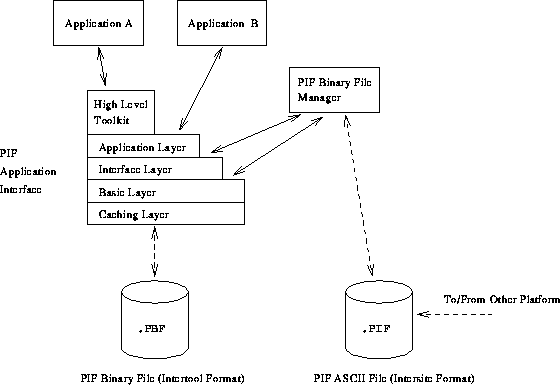2.5.3 The Data Level





Next: 2.5.4 Task Level and
Up: 2.5 VISTA
Previous: The Tool Abstraction
For the data level , the Profile
Interchange Format (PIF) syntax, as initially
proposed by S. Duvall [42], has been chosen as starting point
and refinements and extensions have been added.
Most importantly, obligatory names for every instance of PIF objects and
orthogonal language constructs have been introduced.
The ASCII version of the PIF is used as an inter-site data
exchange format to transfer design information between different
hardware platforms.
, the Profile
Interchange Format (PIF) syntax, as initially
proposed by S. Duvall [42], has been chosen as starting point
and refinements and extensions have been added.
Most importantly, obligatory names for every instance of PIF objects and
orthogonal language constructs have been introduced.
The ASCII version of the PIF is used as an inter-site data
exchange format to transfer design information between different
hardware platforms.
The binary form of PIF [71] is used as the
storage format and for inter-tool communication between
applications on a single hardware platform.
The binary format uses LISP-conforming constructor nodes
(CONS nodes) for the mapping of all ASCII PIF expressions to binary form.
To improve
performance and data compactness, additional features have been
added, such as a symbol hash table for fast object access by name
and a compressed array storage format for large arrays which typically
occur in TCAD applications for physical values defined over multidimensional
grids.
The binary Profile Interchange Format (PIF)
database which holds the semiconductor device structure information is
accessed via the PIF Application Interface (PAI).
The PAI is structured in
seven functional layers with strict interfaces
between each other. The four most important layers
and two applications that use different
functional interfaces of the PAI
are shown in
Figure 2.7.

Figure 2.7: Structure of the PIF application interface
Each layer is responsible for a unique storage concept of the whole
PIF Binary File (PBF),
with increasing functionality and abstraction
towards the upper layers. The application
interface works on PBFs (inter-tool format); for data
exchange with other hosts and for making the contents of the database
human-readable, the PIF ASCII form (inter-site
format) is used. The PIF binary file manager (PBFM),
implemented as a separate application on top of the PAI (see
Figure 2.7), converts PIF files between these two formats.
- Caching Layer.
-
This layer buffers I/O data to minimize disc and
network access.
- Basic Layer.
-
This layer is the lowest level that implements structured data nodes.
It provides a functional interface for the binary storage of full LISP
syntax expressions by presenting the notion of
atoms (primitive data items like integer or floating point numbers,
character or string values)
and constructor nodes (CONS nodes for list creation) to the upper
layers, as described in [72].
In contrast to LISP memory storage concepts, all nodes
of the basic layer (and hence the PIF Application Interface) are
originally kept on file and are just cached through the caching layer.
- Interface Layer.
-
This layer is the implementation of the PIF syntax, providing
administrative, access and inquiry functions.
Through this layer, only syntactically valid (binary)
PIF files can be
read and written
and all named
PIF objects (like points, lines, faces,
attributes) can be inquired by their name or by handle.
As the procedural interface is directly related to the PIF syntax, the
whole interface layer can be generated automatically from an
abstract syntax description during the installation of VISTA.
- Application Layer.
-
The application layer is the most important primary interface
for applications
to read and write simulation data in binary PIF.
Some more semantic rules and their support, like the conversion of
physical units and coordinate
system transformations, are implemented in the application layer.





Next: 2.5.4 Task Level and
Up: 2.5 VISTA
Previous: The Tool Abstraction
Martin Stiftinger
Thu Oct 13 13:51:43 MET 1994
 , the Profile
Interchange Format (PIF) syntax, as initially
proposed by S. Duvall [42], has been chosen as starting point
and refinements and extensions have been added.
Most importantly, obligatory names for every instance of PIF objects and
orthogonal language constructs have been introduced.
The ASCII version of the PIF is used as an inter-site data
exchange format to transfer design information between different
hardware platforms.
, the Profile
Interchange Format (PIF) syntax, as initially
proposed by S. Duvall [42], has been chosen as starting point
and refinements and extensions have been added.
Most importantly, obligatory names for every instance of PIF objects and
orthogonal language constructs have been introduced.
The ASCII version of the PIF is used as an inter-site data
exchange format to transfer design information between different
hardware platforms.





